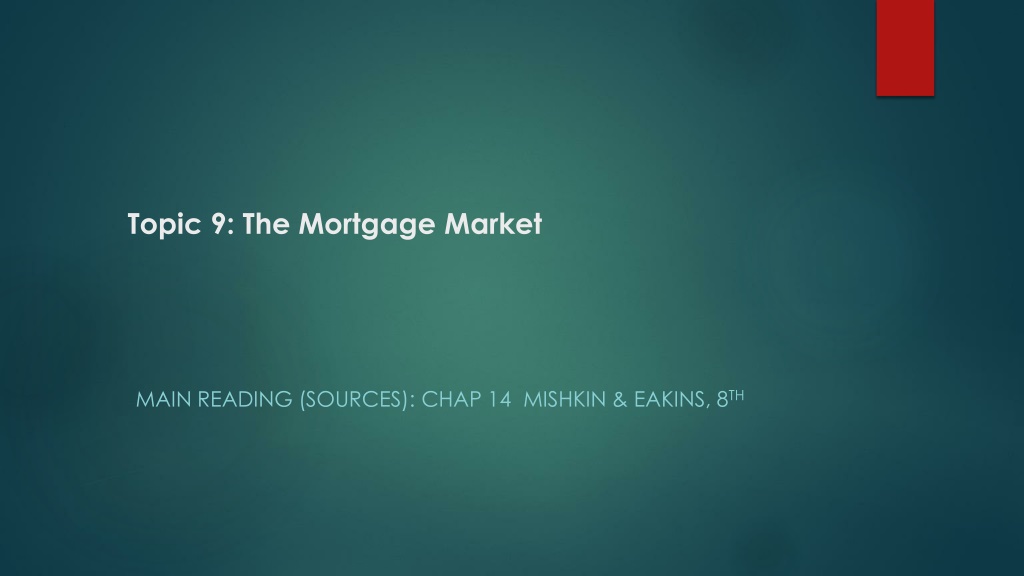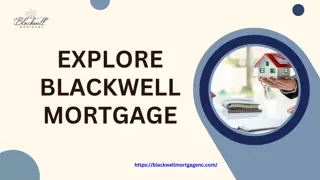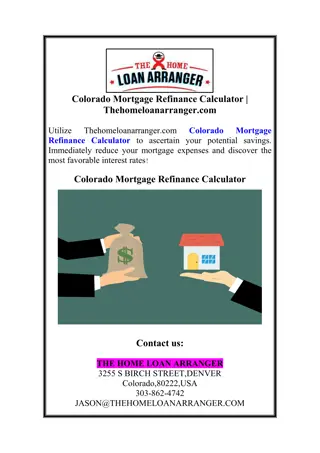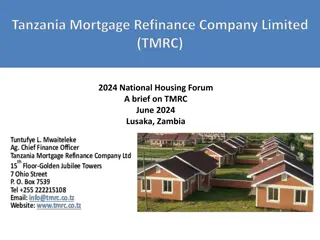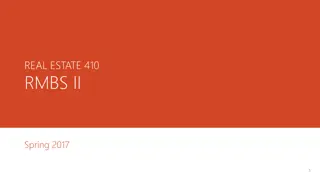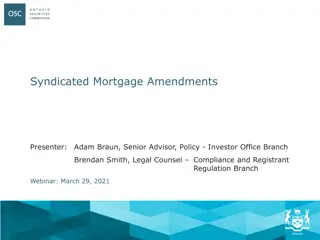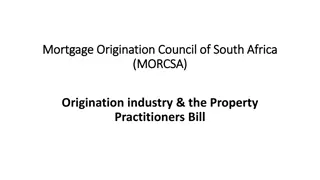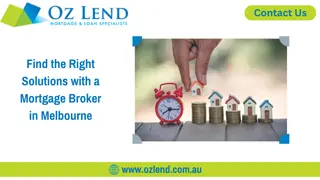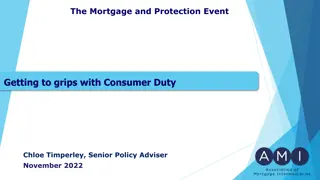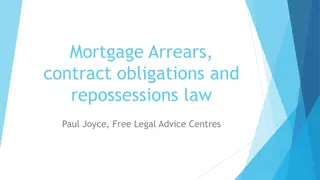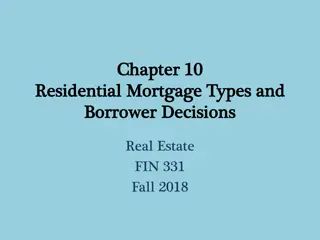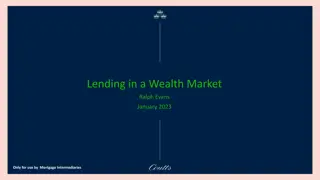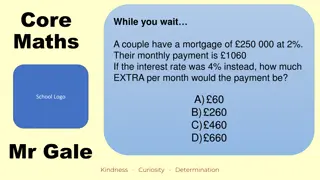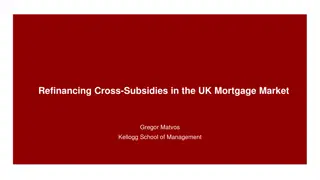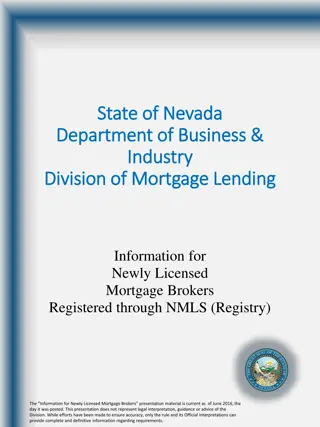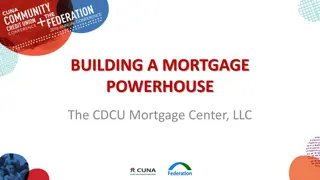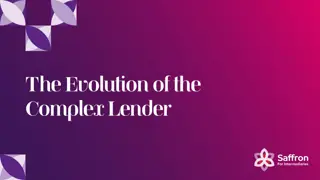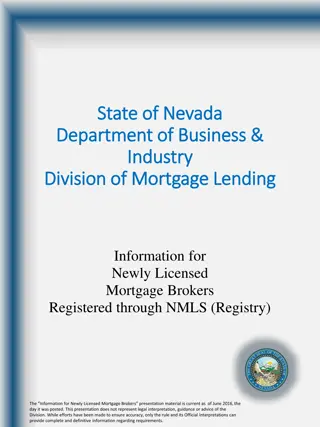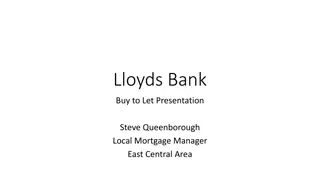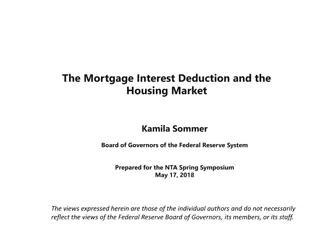Understanding the Mortgage Market: Key Concepts and Trends
The mortgage market is a critical component of the financial system, providing long-term loans secured by real estate. This comprehensive overview covers topics such as mortgages types, loan characteristics, lending institutions, and the history of mortgages. It explores the evolution of mortgage financing from the 1880s to modern-day practices, including the development of the standard 30-year mortgage. The article also delves into key dimensions of residential mortgages, such as interest rates, loan terms, collateral, and amortization. Visual aids like tables and figures further enhance the understanding of mortgage rates and borrowing trends.
Download Presentation

Please find below an Image/Link to download the presentation.
The content on the website is provided AS IS for your information and personal use only. It may not be sold, licensed, or shared on other websites without obtaining consent from the author. Download presentation by click this link. If you encounter any issues during the download, it is possible that the publisher has removed the file from their server.
E N D
Presentation Transcript
Topic 9: The Mortgage Market MAIN READING (SOURCES): CHAP 14 MISHKIN & EAKINS, 8TH
Chapter Preview Topics include: What Are Mortgages? Characteristics of Residential Mortgages Types of Mortgage Loans Mortgage-Lending Institutions Loan Servicing Secondary Mortgage Market Securitization of Mortgages
What are Mortgages? A long-term loan secured by real estate An amortized loan whereby a fixed payment pays both principal and interest each month
Table 14.1 Mortgage Loan Borrowing Type of Property Mortgage Loans Issued ($ billions) Proportion of Total (%) One- to four-family dwelling Multifamily dwelling 9,986 72.38 1,099 7.97 Commercial building 2,506 18.16 Farm 205 1.49
What Are Mortgages? History Mortgages were used in the 1880s, but massive defaults in the agricultural recession of 1890 made long-term mortgages difficult to attain. Until post-WWII, most mortgage loans were short-term balloon loans with maturities of five years or less. Balloon loans, however, caused problems during the depression. Typically, the lender renews the loan. But, with so many Americans out of work, lenders could not continue to extend credit. As a part of the depression recovery program, the federal government assisted in creating the standard 30-year mortgage we know today.
Characteristics of the Residential Mortgage Mortgages can be roughly classified along the following three dimensions: Mortgage Interest Rates The actual rate that banks charge customers is based on the following: Market Rates (based on risk free rates premium) Term (years) Discount Points (upfront fees) Loan Terms Collateral or lien Down Payment (based on LTV) Private Mortgage Insurance (PMI) Insurance for event of default (diff. between Loan and Value) Mortgage Loan Amortization Even amortization (Excel based =pmt(rate/frequency, term x frequency, PV)
Figure 14.1 Mortgage Rates 1971-2024 Source: http://www.federalreserve.gov/releases/h15/data.htm.
Characteristics of the Residential Mortgage: Mortgage Interest Rates & Points Suppose you had to choose between a 12% 30-year mortgage or an 11.5% mortgage with 2 discount points. Which should you choose? Assume you wished to borrow $100,000. First, examine the 12% mortgage. Using the formula Mortgage Payment: ? ?? =LV* 1 (1+?) ? the required payments is: n = 360, i = 0.01, LV = 100,000, Calculate the PMT. PMT = ?
Characteristics of the Residential Mortgage: Mortgage Interest Rates & Points Now, examine the 11.5% mortgage. Using Mortgage Payment ? ?? =LV* 1 (1+?) ? , the required payments is: n = 360, i = 0.115/12=0.0096, LV = 100,000, Calculate the PMT. PMT = ? So, paying the points will save you $38.32 each month. However, you have to pay $2,000 upfront. You can see that the decision depends on how long you want to live in the house, keeping the same mortgage. If you only want to live there 12 months, clearly the $2,000 upfront cost is not worth the monthly savings.
Characteristics of the Residential Mortgage B C D E F G B C D E F G MORTGAGE MORTGAGE 5 Amount= 6 Interest= 7 Term= 8 Frequency= 9 Discount Points % 10 Discount Points $ 11 12 Payment 13 14 15 FORMULA 16 $ 100,000 12.00% 5 Amount= 6 Interest= 7 Term= 8 Frequency= 9 Discount Points % 10 Discount Points $ 11 12 Payment 13 14 15 FORMULA 16 100,000 $ 11.50% 30 12 (yearly=1, Quarterly=4, Monthly=12) 0.00% - $ 30 12 (yearly=1, Quarterly=4, Monthly=12) 2.00% 2,000 $ $1,028.61 =PMT(C6/C8,C7*C8,-C5) =PMT(Rate/Freq,Term x Freq, - Amount) $990.29 =PMT(C6/C8,C7*C8,-C5) =PMT(Rate/Freq,Term x Freq, - Amount) 17 18 19 Payment 20 17 18 19 Payment 20 21 Difference $ 1,028.61 =C5*((C6/C8)/(1-((1+(C6/C8))^-(C7*C8)))) $ 990.29 =C5*((C6/C8)/(1-((1+(C6/C8))^-(C7*C8)))) $ 38.32
Table 14.2 Effective Rate of Interest on a Loan at 12% with 2 Discount Points Year of Payment 1 Effective Rate of Interest (%) 14.54 Year of Prepayment 6 Effective Rate of Interest (%) 12.65 2 13.40 7 12.60 3 13.02 10 12.52 4 12.84 15 12.45 5 12.73 30 12.42
Characteristics of the Residential Mortgage: Mortgage Interest Rates & Points Many mortgage lenders will point to the 30-year effective rate of interest, and argue that the points are a good deal (and it is here, compared to the 12.68% effective rate on a 12% nominal rate mortgage). Although the calculation is correct, the information is not what you need. You need to determine when the present value of the savings ($38.32) equals the $2,000 upfront. Using a financial calculator, this is: i = 1, PV = 2,000, PMT = 38.32 Calculate n. n = 74 months, or about 6.2 years. So, if you think you will stay in the house and not refinance for at least 6.2 years, paying the $2,000 for the lower payment is a sound financial decision. Otherwise, you should accept the 12% loan.
Characteristics of the Residential Mortgage: Loan Terms (1 of 3) Mortgage loan contracts contain many legal terms that need to be understood. Most protect the lender from financial loss. Collateral: usually the real estate being financed, pledged as security Lien: a public record that attached to the title of the property. It gives the lender the right to sell the property if default. Down payment: a portion of the purchase price paid by the borrower Reduce moral hazard problem
Characteristics of the Residential Mortgage: Loan Terms (2 of 3) Mortgage loan contracts contain many legal terms that need to be understood. Most protect the lender from financial loss. Primary Mortgage Insurance (PMI): insurance against default by the borrower Qualifications: includes credit history, employment history, etc., to determine the borrowers ability to repay the mortgage as specified in the contact
Characteristics of the Residential Mortgage: Loan Terms (3 of 3) Lenders will also order a credit report from one of the credit reporting agencies. The score reported is called the FICO. The range is 300 to 850, with 660 to 720 being average. Payment history, debt, and even credit card applications can affect your credit score.
Characteristics of the Residential Mortgage: Loan Amortization Mortgage loans are amortized loans: fixed, level payment pays interest due plus some principal balance on the mortgage will be zero when the last payment is made
Table 14.3 Amortization of a 30-Year, $130,000 Loan at 8.5% Beginning Balance of Loan Monthly Paymen t Amount Applied to Interest Amount Applied to Principal Ending Balance of Loan Payment Number 1 130,000.00 999.59 920.83 78.76 129,921.24 24 128,040.58 999.59 906.95 92.64 127,947.95 60 124,257.09 999.59 880.15 119.44 124,137.65 120 115,366.01 999.59 817.18 182.41 115,183.60 180 101,786.66 999.59 720.99 278.60 101,508.06 240 81,046.91 999.59 574.08 425.51 80,621.40 360 992.56 999.59 7.03 992.56 0.00
Types of Mortgage Loans (1 of 2) Insured vs. Conventional Mortgages: if the down payment is less than 20%, insurance is usually required Fixed-Rate Mortgages: the interest rate is fixed for the life of the mortgage Adjustable-Rate Mortgages: the interest rate can fluctuate within certain parameters
Types of Mortgage Loans (2 of 2) Other Types Graduated-Payment Mortgages (GPMs) for home buyers their income will rise Growing Equity Mortgages (GEMs) for home buyers that want to pay faster Second Mortgages secured by the same assets than the first mortgage Reverse Annuity Mortgages (RAMs) for retired people that want to live off the equity built on their home Option ARMs Option to Adjustable-Rate Mortgages The following table lists additional characteristics on all the loans.
Table 14.4 Summary of Mortgage Types (1 of 2) Conventional mortgage Loan is not guaranteed; usually requires private mortgage insurance; 5% to 20% down payment Loan is guaranteed by FHA or VA; low or zero down payment Interest rate is tied to some other security and is adjusted periodically; size of adjustment is subject to annual limits Initial low payment increases each year; loan amortizes in 30 years Insured mortgage Adjustable-rate mortgage (ARM) Graduated-payment mortgage (GPM)
Table 14.4 Summary of Mortgage Types (2 of 2) Growing-equity mortgage (GEM) Initial payment increases each year; loan amortizes in less than 30 years Second mortgage Loan is secured by a second lien against the real estate; often used for lines of credit or home improvement loans Reverse annuity mortgage Lender disburses a monthly payment to the borrower on an increasing-balance loan; loan comes due when the real estate is sold
Mortgage-Lending Institutions Originally, thrift institutions were the primary originator of mortgages in the U.S. and, therefore, the primary holder of mortgage loans. As the next figure illustrates, this is not the case anymore.
Figure 14.2 Share of the Mortgage Market Held by Major Mortgage-Lending Institutions Source: http://www.federalreserve.gov/econresdata/releases/mortoutstand/current.htm.
Loan Servicing Most mortgages are immediately sold - frees cash to originate another loan. Loan servicers collect monthly payments, usually keeping a portion of the payments received. In all, there are three distinct elements in mortgage loans: The originator packages the loan for an investor The investor holds the loan The servicing agent handles the paperwork
E-Finance: Borrowers Shop the Web for Mortgages Mortgages used to originate from a local bank. But the web is well-suited to handle online mortgage origination: This is a financial product nothing really needs to be delivered Mortgages are fairly standardized. There is no product differentiation to consider. Little bank loyalty for borrowers Online lenders have low overhead, and so lower fees.
Secondary Mortgage Market The secondary mortgage market was originally established by the federal government after WWII when it created Fannie Mae to buy mortgages from thrifts. The market experienced tremendous growth in the early to mid-1980, and has continued to remain a strong market in the U.S.
Securitization of Mortgages The securitization of mortgages developed because of the risk of default and costs of prepayment / servicing. A pool of mortgages reduces this problem through diversification. The mortgage-backed security (MBS) is created. Pools including hundreds of mortgages. Rights to the cash flows sold as separate securities. At first, simple pass-through securities were designed.
Securitization of Mortgages: The Mortgage Pass-Through Definition: A security that has the borrower s mortgage payments pass through the trustee before being disbursed to the investors This design did eliminate idiosyncratic risk, but investors still faced prepayment risk. The value of mortgages held in pools is reaching nearly $8.0 trillion near the end of 2009. Fell dramatically The securities compete for funds along with all other bond market participants.
Figure 14.3 Value of Mortgage Principal Held in Mortgage Pools, 19842016 Source: http://www.federalreserve.gov/econresdata/releases/mortoutstand/current.htm.
Securitization of Mortgages: Types of Passthroughs There are a variety of different types of pass-through securities. We will briefly look at three: GNMA Pass-Throughs Government National Mortgage Assoc. FHLMC Pass-Throughs Federal Home Mortgage Corporation Private Pass-Throughs Collateralized Mortgage Obligations (CMO)
Securitization of Mortgages: GNMA Passthroughs Ginnie Mae began guaranteeing passthroughs in 1968. GNMA mortgages can be originated by many different financial institutions. GNMA aggregates the mortgages and issues passthroughs with rights to interest and principle. GNMA also offers default insurance on the mortgages in the pools.
Securitization of Mortgages: FHLMC Passthroughs (1 of 2) Freddie Mac buys mortgages and packages them for resale in MBSs. FHLMC pools contain mortgages that are not guaranteed, and may have different rates, etc. Pass-through securities issued by Freddie are called participation certificates.
Securitization of Mortgages: FHLMC Passthroughs (2 of 2) Definition: A CMO is a structured MBS where investor tranches have different rights to different sets of cash flows. This design structured the prepayment risk. Some tranches had little prepayment risk, while other had a lot. Freddie Mac helped originate these structures, and continues to innovate new tranche designs.
Securitization of Mortgages: Private Passthroughs BankAmerica offered the first private pass-through in 1977. Non-agency issuers are free to incorporate any type of mortgages into their MBSs, including jumbo loans, Alt-A loans, and other non-traditional mortgages.
Subprime Mortgages and CDOs (CMOs) (1 of 2) Subprime loans are loans to borrowers who have poor credit ratings or other issues with collateral, etc. In 2000, only 2% of mortgages were subprime. This climbed to 17% by 2006. The average FICO score was 624 for subprime borrowers. Prime mortgage borrowers were 742. However, these mortgages were hailed by politicians and bankers alike. They helped less-then-perfect borrowers secure the American Dream of owning a home. And since real estate prices can t fall , there is little risk involved.
Metanext CDO Fund IV (MDLO) (COMPANY C) * MDLO Summary Income Statement Revenues 6.00% Interest Exp. 2.52% Mgmt Fee 0.50% Total Income ROE % Subprime Mortgages and CDOs (CMOs) (1 of 2) 30.00 $ (11.32) (2.50) 16.18 $ 32.36% mm PORTFOLIO OF INVESTMENTS Investments in Leveraged Loans HIGH YIELD BOND FUND: Capital Raising as follows: mm DEBT TRANCHES: Tranche A (AAA) Tranche B (AA) Tranche C (A) $450mm Tranche D (BBB) Tranche E (BB) Loan A Loan B Loan C Loan D Weighted Average Cost of Debt 2.52% Loan E Loan F Loan G Loan H Loan I Loan K Loan L Loan M METANEXT CLO INVESTMENT & PORTFOLIO MANAGEMENT COMPANY Capital Structure Loan P Loan N Loan O Loan Q Par EQUITY TRANCHE $50 million Rating S&P/M Coupon Payment WACD Tranches amount ($ mm) % Cap % Debt $500 million Loan S Loan T Loan R Loan U Weighted Average Portfolio Revenue 6.0% 1.80% 1.34% 74.4% Portfolio Management Fee 0.5% Loan X Loan Z Tranche A Tranche B Tranche C Tranche D Tranche E Total Debt Equity 335.0 41.0 30.0 27.0 17.0 450.0 50.0 500.0 100.0% 67.0% 8.2% 6.0% 5.4% 3.4% 90.0% 10.0% AAA/Aaa AA/Aa2 A/A2 2 BB/Ba2 Loan V Loan W 3.00% 4.00% 6.00% 7.30% 0.27% 0.27% 0.36% 0.28% 9.1% 6.7% 6.0% 3.8% 100.0% Loan AA Loan AB Loan AC Loan AD Loan AE Loan AF Loan AG Loan AH NR Loan AI Loan AJ Loan AL Loan AK 2.516%
Subprime Mortgages and CDOs (CMOs) (2 of 2) Several factors lead to this dramatic increase in subprime lending: New mortgage products (2/28 ARMS, Option ARMS, NoDoc loans) made expensive houses affordable (sort- of). The creation of CDOs helped create deal flow to continue lending in subprime markets. The credit derivative of mortgage security that has several tranches is the collateralized mortgage obligations (CMO) When house prices were increasing, subprime borrowers had an out if problems arose.
The Real Estate Bubble (1 of 2) Between 2000 and 2005 home prices increased an average of 8% per year. The run up in prices was cause by two factors: The increase in subprime loans created new demand for housing Real estate speculators
The Real Estate Bubble (2 of 2) In the aftermath of the financial meltdown, lending policies have largely returned to selecting capable borrowers: CDO issuance peaked in 2006 at $520b, but in 2009 fell to $4.2b. Up to $58b in 2012. New legislation, such a Frank-Dodd, may require mortgage originators to hold a part of the mortgages they create.
Chapter Summary (1 of 2) What Are Mortgages? Loans made for the purchase on real property, and usually collateralized by the purchased property. Characteristics of Residential Mortgages: includes the length of the mortgage, the terms, and the rate charges for the loan Types of Mortgage Loans: includes conventional, insured, fixed and variable rate, and a variety of other designs. Mortgage-Lending Institutions: the primarily originator and holder of mortgages is no longer thrift institutions as other attempt to generate fees
Chapter Summary (2 of 2) Loan Servicing: the fees generated by collecting, distributing, and recording payments Secondary Mortgage Market: the active market for mortgages after the mortgage has been originated Securitization of Mortgages: growing in popularity, causing mortgages to complete with both Treasury and corporate debt. But also clearly a part of the problem in the Housing Bubble and Financial Crisis of 2007 2009.
